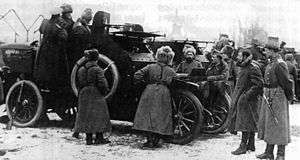Belgian Expeditionary Corps in Russia
| Belgian Expeditionary Corps in Russia | |
|---|---|
|
Mors-Minerva armoured car of the Belgian Expeditionary Corps in Russia, c.January 1916 | |
| Active | 1915–1918 |
| Country |
|
| Allegiance |
|
| Branch | Imperial Russian Army |
| Type | Mechanised |
| Role | Mobile reconnaissance |
| Size | 444 men (total)[1] |
| Garrison/HQ | Peterhof, Saint Petersburg (1915) |
| Equipment | Mors-Minerva and Peugeot armoured cars |
| Engagements | Eastern Front. |
| Disbanded | July 1918[1] |
The Belgian Expeditionary Corps of Armoured Cars in Russia (French: Corps Expeditionnaire des Autos-Canons-Mitrailleuses Belges en Russie) was a Belgian military formation during the First World War which was sent to Russia to fight the German Army on the Eastern Front. Between late 1915 and 1918, 444 Belgian soldiers served with the unit of whom 16 were killed in action.[1]
History
As the front line in the west stabilized following the Battle of the Yser, the Belgian army was left with a number of armoured cars that could not be used in the static trench warfare which had emerged along the Belgian-held Yser Front. In early 1915, Tsar Nicholas II formally requested military support from King Albert I and a self-contained unit was formed for service in Russia.[2] As Belgium was not officially an ally of the Russian Empire but a neutral power, the Belgian soldiers in the unit were officially considered as volunteers in the Imperial Russian Army itself.
The first contingent of the Belgian Expeditionary Corps, 333 volunteers equipped with Mors and Peugeot armoured cars, arrived in Archangel in October 1915.[1] The unit fought with distinction in Galicia and was mentioned in the Order of the Day five times.[3]
After the Bolshevik Revolution in 1917, the Belgian force remained in Russia until the Treaty of Brest-Litovsk withdrew Russia from the war. After the ceasefire, the unit found itself in hostile territory. As the route north to Murmansk was blocked, the soldiers destroyed their armoured cars to prevent their capture by Bolshevik forces.[3] The unit finally reached the United States through China and the Trans-Siberian railway in June 1918.[1]
A similar, slightly larger British unit, the Armoured Car Expeditionary Force (ACEF), also served in Russia during the same period.
Notable personnel

The unit was never particularly numerous, but included some notable personnel:
- Marcel Thiry, Walloon poet, who served in the corps with his brother Oscar.
- Henri Herd, known as "Constant le Marin", who was a prominent boxer and 4-time World Champion
- Julien Lahaut, politician and chief of the Communist Party of Belgium who was assassinated in 1950.
- Théo Halleux, well-known construction contractor who built the first high multistorey buildings in Liège.
Commemoration
From 1931, soldiers who had served with the unit were awarded the 1914–1918 Commemorative War Medal with a bar (reading "1916-R-1917" or "1916-R-1918") denoting service in Russia.[4] The last veteran of the unit died in 1992.[1]
The 2015 Belgian animated film Cafard tells the story of a boxer, Jean Lemarin (based on the real-life Henri Herd, known as Constant le Marin), who joins the Expeditionary Corps in order to avenge the rape of his sister by German soldiers in Occupied Belgium.[5] In 2014-15, the Royal Museum of the Armed Forces and Military History in Brussels raised 40,000 euros towards building a replica Mors-Minerva armoured car. The result, first exhibited in 2015 in the insignia of the Expeditionary Corps, went on display in 2015.[6]
See also
References
- 1 2 3 4 5 6 "Belgian Armoured Cars in Russia". www.greatwardifferent.com. Retrieved 21 December 2012.
- ↑ White, B.T. Tanks and Other Armoured Fighting Vehicles 1900-1918, Blandford Press, 1974. p129-130.
- 1 2 "WWI – Belgium Armoured Car Division in Russia". www.philatelicdatabase.com. Retrieved 21 December 2012.
- ↑ "The Russia-bar "1916-R-1917"". Retrieved 21 December 2012.
- ↑ ""Cafard", l'un des rendez-vous de la rentrée". Le Soir. 23 September 2015. Retrieved 20 December 2015.
- ↑ "2015, elle va renaître". Klm-mra.be. Royal Museum of the Armed Forces and Military History. Retrieved 20 December 2015.
External links
- "WWI – Belgium Armoured Car Division in Russia". www.philatelicdatabase.com. Retrieved 21 December 2012.
- "'Opérations des Auto-canons-mitrailleuses Belges en Russie" (in French). Touring Club de Belgique (1918).
